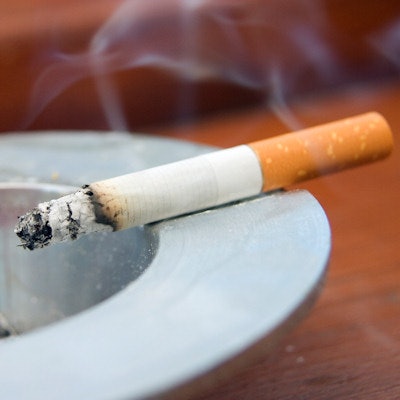
Smokers have an increased risk of oral disease but use dental care at lower rates than nonsmokers, so the researchers of a new study sought to understand the factors affecting oral healthcare use in low-income smokers.
They examined data from smokers who called state-funded phone lines that offered assistance with quitting tobacco use and had not recently received dental care. Those with dental insurance were more likely to see a dentist during the follow-up period, but the researchers found no differences among those citing cost as a barrier.
"This information could inform the development of future interventions to promote dental care utilization," wrote the study authors, led by Paula Blasi, MPH, a research associate at Kaiser Permanente Washington Health Research Institute in Seattle (BMC Oral Health, November 1, 2018).
No more blowing smoke
Smokers are about twice as likely as nonsmokers to have not seen a dentist during the previous five years or ever, even though regular dental visits may reduce the negative effects of their habit.
“This information could inform the development of future interventions to promote dental care utilization.”
In the current study, the researchers sought to increase knowledge about predisposing or enabling factors that facilitated or hindered dental care utilization among smokers overdue for such care. They conducted a secondary analysis of data collected between June 2015 and March 2017 from 718 smokers who called tobacco quit phone lines in Oregon, Nebraska, and Louisiana.
The researchers initially recruited participants for a program designed to encourage dental care utilization among smokers. They randomized them to receive dental care in addition to the usual quit line care or to receive quit line care only. However, dental care use at the six-month follow-up visit was the same in the two groups, and the researchers combined them in the current analysis.
Participants were 18 years and older, ready to quit smoking, had no dental appointments in the previous or following six months, and had an interest in improving their oral health.
Researchers collected the following information from participants:
- Demographic data
- Oral health-related self-reported items
- Dental insurance status
- Self-ratings on a scale from 1 ("definitely not true") to 5 ("definitely true") for 11 common barriers to dental care, with ratings of 4 to 5 deeming that the barrier was present
- Motivation and self-efficacy to see a dentist on a scale from 1 ("not at all motivated/confident") to 5 ("very motivated/confident"), with ratings of 4 and 5 deemed as "high" motivation or self-efficacy and lower ratings as "low"
The researchers calculated the following demographic characteristics of the participants:
- Close to two-thirds had an annual household income of less than $20,000.
- In terms of education, 55% had no more than a high school education.
- Regarding race/ethnicity, 59% were white, 29% were black, and 13% stated they were other or of multiple races.
- Almost all were younger than age 65.
At baseline, almost 87% of the participants had not undergone a dental cleaning in more than a year, and almost 42% hadn't in more than five years or had never had one. They reported high levels of motivation (more than 81%) and self-efficacy (67%) for having a dental visit in the next six months.
At the six-month follow-up, the researchers asked participants who reported a dental visit to provide the practitioner's name for potential verification. The one-third of participants with dental insurance were more likely to have seen a dentist during the six months than were those without it, with those reporting that a lack of dental insurance was a barrier to care (more than 78%) were less likely to have had a dental visit. Of the almost 88% who cited cost as a barrier, 17.5% did not see a dentist during this time, compared with just over 23% not reporting this barrier, which was not a significant difference.
Multiple variables were significantly associated with a higher rate of reported dental care utilization at the six-month follow-up in an adjusted model (see table below).
| Baseline characteristics associated with dental care utilization at the 6-month follow-up | |||
| Baseline characteristic | p-value | ||
| Marital status | Married or living as married (14.4%) | Single (21.0%) | 0.02 |
| Education | GED, high school degree, or less (14.4%) | At least some college, technical school, or trade school (23.9%) | 0.013 |
| Living with a disability (employed or unemployed) | No disability (15.2%) | Disability (26.5%) | 0.004 |
| Last dental cleaning | More than one year ago or never (15.7%) | Less than one year ago (36.2%) | < 0.001 |
| Perceived gum disease | No perceived gum disease (15.8%) | Perceived gum disease (22.1%) | 0.014 |
| Motivation to see dentist in the next 6 months | Low motivation (7.5%) | High motivation (20.9%) | 0.029 |
| Self-efficacy to see a dentist in the next 6 months | Low self-efficacy (9.7%) | High self-efficacy (22.7%) | 0.019 |
"The results of our randomized trial and the findings from this secondary analysis suggest income, geographic classification, and perceived barriers may be less important drivers of future dental care among low-income smokers than one's motivation to see a dentist or confidence in one's ability to see the dentist," the authors wrote.
Quitting time
The researchers noted that their results were not necessarily generalizable to smokers who have higher incomes, are from other states, visit a dentist regularly, have not called a quit line, or are not interested in improving their health. Additionally, data were based on self-reports and subject to bias and misreporting.
Nevertheless, the results can be used to help increase dental care utilization in people with low incomes and smokers, the authors wrote.
"This information can inform the design of future oral health promotion programs either by helping public health officials target those at greatest risk for not seeking dental care (e.g., smokers with lower education levels) or by suggesting potential targets for future behavioral interventions (e.g., perceived disease risk, self-efficacy, motivation)," they concluded.


















